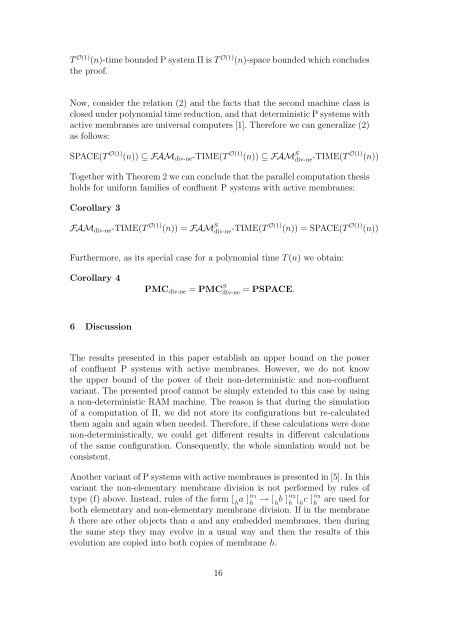P Systems with Active Membranes Characterize PSPACE
P Systems with Active Membranes Characterize PSPACE
P Systems with Active Membranes Characterize PSPACE
Create successful ePaper yourself
Turn your PDF publications into a flip-book with our unique Google optimized e-Paper software.
T O(1) (n)-time bounded P system Π is T O(1) (n)-space bounded which concludesthe proof.Now, consider the relation (2) and the facts that the second machine class isclosed under polynomial time reduction, and that deterministic P systems <strong>with</strong>active membranes are universal computers [1]. Therefore we can generalize (2)as follows:SPACE(T O(1) (n)) ⊆ FAM div-ne -TIME(T O(1) (n)) ⊆ FAM S div-ne-TIME(T O(1) (n))Together <strong>with</strong> Theorem 2 we can conclude that the parallel computation thesisholds for uniform families of confluent P systems <strong>with</strong> active membranes:Corollary 3FAM div-ne -TIME(T O(1) (n)) = FAM S div-ne-TIME(T O(1) (n)) = SPACE(T O(1) (n))Furthermore, as its special case for a polynomial time T (n) we obtain:Corollary 4PMC div-ne = PMC S div-ne = <strong>PSPACE</strong>.6 DiscussionThe results presented in this paper establish an upper bound on the powerof confluent P systems <strong>with</strong> active membranes. However, we do not knowthe upper bound of the power of their non-deterministic and non-confluentvariant. The presented proof cannot be simply extended to this case by usinga non-deterministic RAM machine. The reason is that during the simulationof a computation of Π, we did not store its configurations but re-calculatedthem again and again when needed. Therefore, if these calculations were donenon-deterministically, we could get different results in different calculationsof the same configuration. Consequently, the whole simulation would not beconsistent.Another variant of P systems <strong>with</strong> active membranes is presented in [5]. In thisvariant the non-elementary membrane division is not performed by rules oftype (f) above. Instead, rules of the form [ ha ] α 1h → [ h b ] α 2h [ h c ] α 3are used forhboth elementary and non-elementary membrane division. If in the membraneh there are other objects than a and any embedded membranes, then duringthe same step they may evolve in a usual way and then the results of thisevolution are copied into both copies of membrane h.16
















